This article is part of the 31 Days of Pinterest Hacks series. Find the main page for this series here.
We received a beautiful child-size IKEA table and chairs set as a gift for my son shortly after he was born. After I got over the initial excitement, I remembered that my son might be unable to sit on those chairs and play at that table for a long time, if at all. Disappointment set in. I imagined my little guy would only be subjected to ugly, clinical-looking equipment for the rest of his life.
When my son’s second birthday came around, I pulled out that set and tried a billion ways to get him to stay on it with some support. Sadly, nothing I invented was safe enough to hold him there securely. I was determined. I brought the chair to our rehabilitation center’s seating department and asked the technician to work his magic. He had a solution for us. From that day on, I’ve only looked at the possibilities kids’ furniture hold.
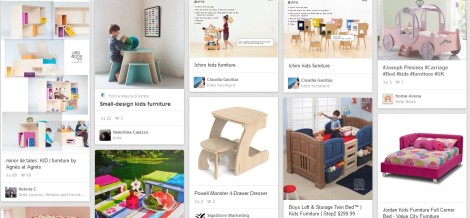
While the many beautiful pieces of furniture pinned on Pinterest may not work for every child, don’t despair. I’ll show you some safe adapted alternatives I’ve found.
Why some furniture may be a challenge for neurodivergent or disabled children
- Children with physical disabilities need secure equipment to keep them safe in any piece of furniture. Furniture sold in local shops is not adapted.
Suggestions for adapted equipment/furniture
The suggestions below are based on our experience. I share some of the most attractive and functional pieces I’ve found. However, always consult with the child’s specialists before deciding on furniture for any disabled child.
Seating
Have a proper place for the child to sit when engaging in fine motor activities. Having the child’s lower body and trunk supported is important to get the best results with their hands.
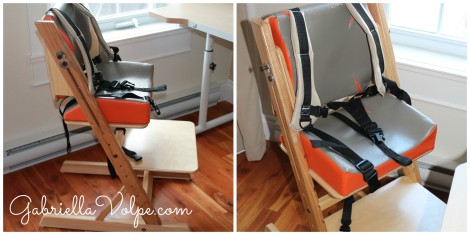
This chair was custom-made by a locally-run small business that makes adapted equipment for disabled children. The craftsman came to the home to learn about our needs and designed the chair accordingly. You’ll notice how it’s rather attractive. It’s made of wood and fits right into our décor. We have a tray that goes along with it for feedings. It can be pushed underneath all standard-sized tables and grows with the child.
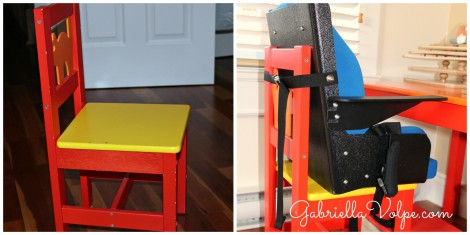
This is the set of table and chairs that my little guy received as a gift. You can see the insert that the technician at our rehabilitation center made. Notice the footrest this creative technician added to make the chair even more comfortable. My son can sit at the table with peers and not be an outsider when they visit. Visiting children often want to sit in that chair themselves!
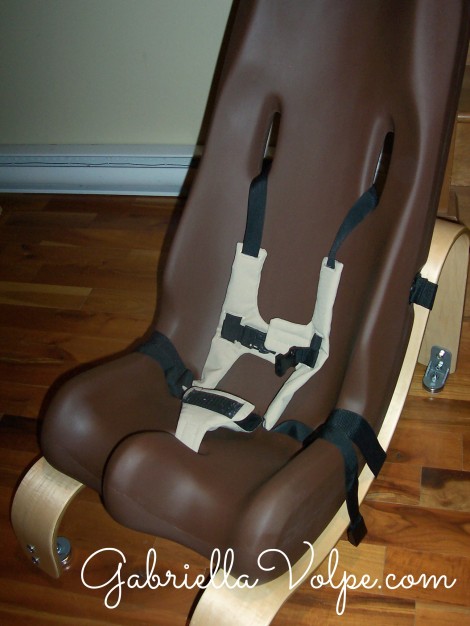
We purchased this seat because we needed something portable for when we visit others. It’s made specifically for disabled children. It’s soft and comfortable (I’ve sat in it myself). We sit our little guy in here when spending time together in the living room. It’s a little more comfortable than the feeding seat, and, what do you know? It also blends in with our home furnishings!
Desk
Even though it might not seem significant, the table/desk you work at with a child is important. A few times, before we used a desk, we tried to work on crafts on my son’s tray table, which we also use for feeding. As soon as I placed the tray in front of my son, he’d request food. He associated the feeding chair with meals. I needed a separate seat to work on other activities.
It makes sense. I wouldn’t say I like to eat at the same place I use glue for crafting. I know that sometimes, there is no other choice. If possible, try to have a different surface to work on academic activities. This helps the child transition from one task to another simply by associating with the various pieces of furniture.
If it’s impossible to have the child seated at a table or desk, work in a different space. If the child needs to use the tray that comes with their wheelchair (or if the feeding chair is your only option), move the chair to a different space from where they are fed. This will help the child differentiate between different activities.
This idea is also doable for the child who doesn’t need adapted equipment. Set a special place for the child to work on school tasks. If it has to be a table, let them sit where they don’t ordinarily sit to eat. A simple change in space significantly affects motivation, concentration, and learning.
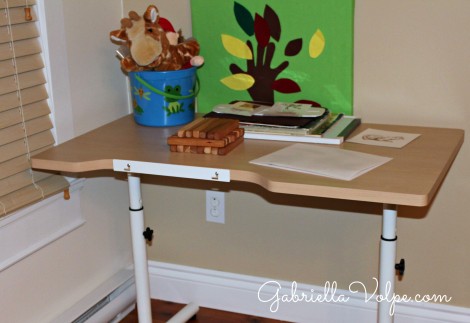
Our adapted desk allows my son’s adapted seat to slip right under. We move it away from the wall so I can sit and face him on the other side. There are no obstructions underneath the desk, so both our legs fit nicely. It’s also high enough that I don’t strain my back when I stand behind him to model or do anything hand-over-hand (always if he consents). Notice how it is a neutral color and blends with the rest of the house décor.
Bed
When my son outgrew the crib, the options offered by the local community services center did work for us. They were clinical-looking and clunky, and frankly, they made me sad. I didn’t want my son’s sleep space to look like a hospital.
While browsing through a catalogue, one day, I noticed they sold bed tents for children. I thought about how much fun that must be for children. But again, the open sides didn’t make it a safe possibility for us. I found an adapted version designed by a mother of an Autistic child.
What does a bed have to do with homeschooling? Each afternoon, we have a rest period as part of our rhythm. While my son doesn’t nap anymore, he’s placed on his bed to “rest his bones,” as I say. He loves being in there, and I get a little break, too, knowing he’s in a safe place.
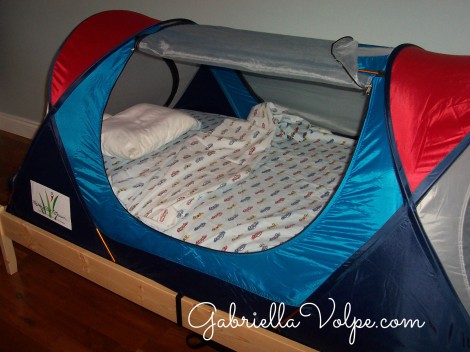
This tent zips outside so the child can’t get out on their own (unless it’s safe to leave it open). It’s breathable and secure. I love this purchase as it also saved our nights. Update: This bed tent is now discontinued, but there are other variations on the market. We currently use the new bed tent with the mattress directly on the floor so that my son can get in and out safely on his own.
What pieces of furniture/equipment do you use?
Are you looking for additional support? I offer personalized consultations offering ideas such as these!
Related Articles:

0 Comments